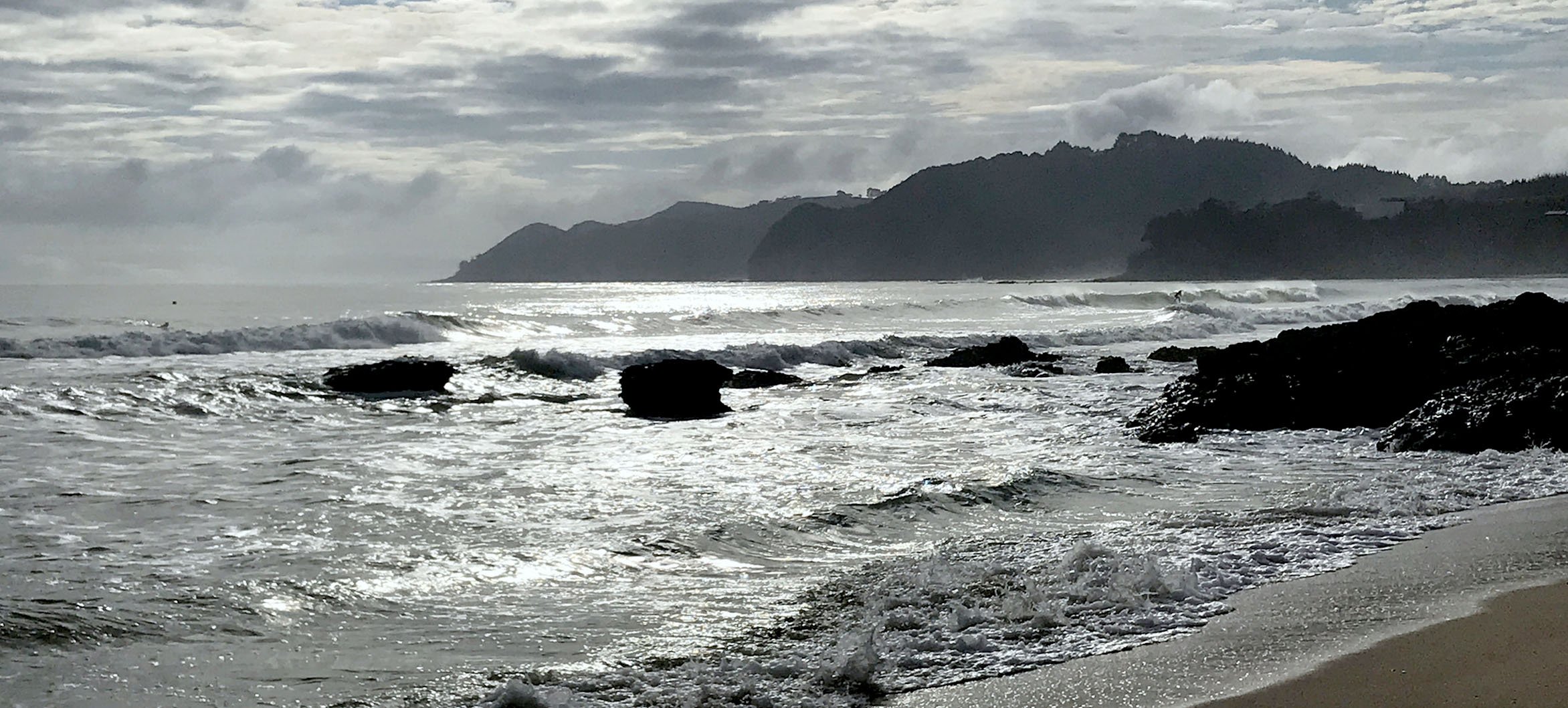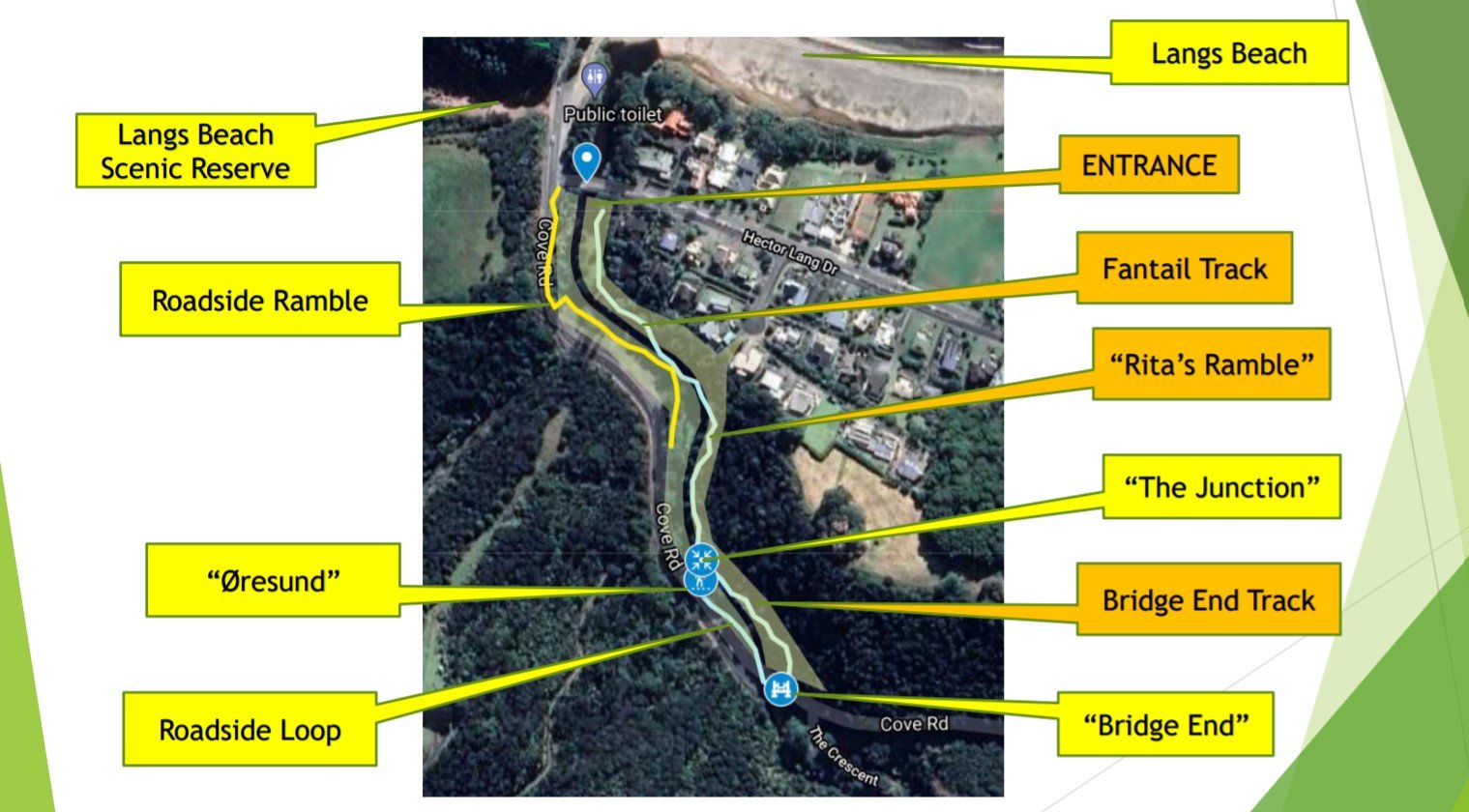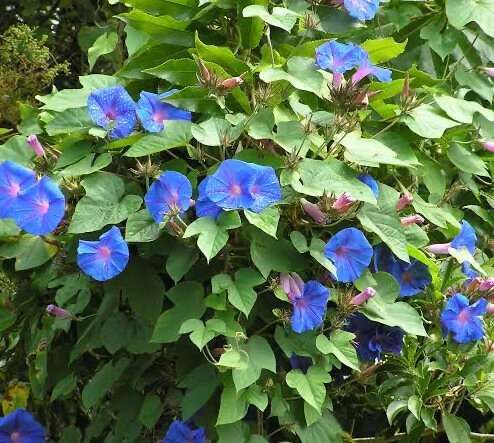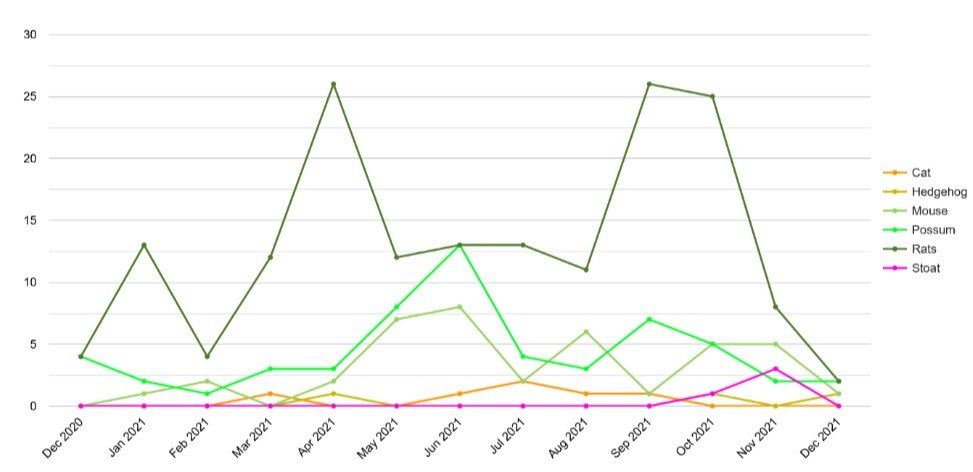
Development of Walking Tracks
The primary objective of the Trust is the development of a network of connected walking tracks in the Langs Beach area.
During the past year hundreds of volunteer hours, sweat and tears have been spent building and extending over 6 kms of tracks in the Langs Beach Scenic Reserve and beside the Wairahi Stream.
These tracks have grown to become an attractive amenity for locals and visitors who wish to enjoy these areas of restored natural bush that both contrast and complement the popular beach environment.
(See Track Maps and Descriptions)
To date, our track development activities have been focused on two reserves as briefly described below
Langs Beach Scenic Reserve Tracks
At 15 hectares, the Langs Beach Scenic Reserve is the largest reserve in our immediate area, and one that had languished unused for 30 years becoming infested by weeds. Initial work involved removing significant wild ginger infestations, revealing an old farm road which was then developed to become our “Main Track”, an easy grade that runs for 750m from the entrance on Cove Road to a boundary gate in the top SE corner of the reserve.
There is now an upper loop track which branches from the ‘Main Track’, down ‘The Shoulder’ to ’Fantail Flat’, then up ‘Tapper Track’, and around the top boundary of the reserve. A junction half way along gives the option to return to Fantail Flat via the ‘Cascades Track’, or continue along the loop track and drop down into Canyon Creek Track, joining with the Puriri Loop Track.
The plan for the 2022 year is to continue to improve track surfaces to support the growing use of these tracks by the community.
It is expected that the access track network in the Langs Beach Scenic Reserve will be completed in 2022.
Wairahi Stream (“Bridge-to-Bridge”) Tracks
Our “Bridge-to-Bridge” tracks have been developed in the esplanade reserves running alongside the Wairahi Stream, between the Lang Cove bridge and the one-lane bridge to the south. These tracks pass through attractive stands of mature totara and nikau, as well as areas where the Trust has planted natives to replace roadside weeds.
The Trust is now looking at supporting the development of other walking and biking trails in the area such as the improvement of the Coastal Walkway from Langs Beach to Waipu Cove. The new owner of Waorahi, a 190ha block on the ridgeline behind Langs beach has also become part of the Trust and has extensive plans for development and restoration of his land. Track building work in this area will be linked with the Te Araroa trail which runs through the property.
Natural Habitat Restoration
The Wairahi Tracks group has mainly worked to restore two areas at Langs Beach. These are the Langs Beach Scenic reserve, the entrance to which is across the road from the carpark, and what we call the “bridge to bridge” area, which lies beside the road on the approach to Langs from the South. This area follows both sides of the stream from the bridge at Lang Cove to the bridge at the entrance to Langs Beach Estate. The scenic reserve is administered by the Department of Conservation while the bridge to bridge area is administered by the Whangarei District Council.
The first task has been to remove weeds and pests:
When work first began in the reserve the most overwhelming problem was vast areas of head-high ginger plants. The task seemed impossible. Many days of weed whacking and slash and paste techniques by local and DoC volunteers were needed to get rid of the majority of the ginger. Then volunteers tackled infestations of climbing asparagus fern, blackberry, pampas, woolly nightshade, and cotoneaster; spraying, weed eating, hand pulling and chopping .
In the bridge to bridge area the pest plants included climbing asparagus fern, ladder fern and many montbretia and watsonia bulbs that required hand removal. We sprayed and weeded jasmine, pampas, onion weed, nasturtium, and morning glory, as well as out of control wisteria that was smothering the trees. Much of this walkway is still weedy so is a ‘work in progress’ but ultimately it will be a lovely spot for a picnic by the river.
Now we can start to plant and regenerate the area
It is exciting when we can begin to plant in newly cleared areas . In the reserve we are following a planting plan commissioned from “Rural Design.”
All plants are native to our particular wetland - sedges, reeds, manuka, kanuka, cabbage trees (tī kōuka) and kahikatea and more recently kowhai and native hibiscus as well as five-finger (whauwhaupaku), kahikatea, flaxes (harakeke), manuka and kanuka.
Unfortunately rabbits and pukekos have enjoyed the planting as much as we have and we’ve needed to ‘sleeve’ many of the plants .
Read below about the worst weeds in the area
Predator Control
Predator control has been undertaken in the Langs Beach Scenic Reserve since December 2020 under the guidance of Waipu Kiwis. Targeted species are predominantly rats, possums and stoats. A network of traps has been placed throughout the reserve utilising the access tracks that have been constructed by the Wairahi Tracks Charitable Trust. This comprises 10 possum traps, approximately 15 rat traps and 5 stoat traps. The traps are complemented by the use of a track camera to ensure the traps are placed in optimal locations and most desirable lures are used.
Predator Statistics in the Langs Beach Scenic Reserve
To date (December 2021) approximately 50 possums and 180 rats have been caught and we were delighted to catch three stoats recently. In addition, 40 mice, six feral cats and two hedgehog have also been trapped. Monthly totals vary significantly by season with the greatest number of rats caught in April and September and June being the boom month for possums. This is illustrated by the graph at right
As you see there are currently low numbers of predators being trapped in the reserve – time will tell whether this is seasonal or if we have managed to get them under control, although it seems that it is reasonably easy to catch the young and naïve animals but much harder to capture the older wiser ones that can be trap shy. We are hoping that as a result of the predator control being undertaken in the reserve and adjoining properties there will be an increase in bird life after this nesting season and one day we will be able to hear bellbird (korimako) and kiwi in our local area.
If you would like to take part in this rewarding (and fitness-building!) activity, please contact Kathryn via email to info@wairahitracks.nz.
Create Community Involvement
As part of the Wairahi Tracks Trust plan for Langs Beach, the Friday ‘Trackies’ have met each Friday at 9.00 am. After a short Health and Safety briefing, the work begins on making tracks, clearing, spraying, mulching or planting as the programme demands in the current project for the Langs Beach area.
People have been so generous with their time and their equipment: spraying units, tractors, mulching machines. The added bonus to this working party is the now famous bacon and egg pie, made by Christine Birss which appears every Trackies Friday at 11.00 over morning tea and chat. Countless volunteer hours have been put into this effort, both at Trackies and in private time.
In May 2024 we completed Friday Trackies no. 200 !
The Saturday ‘Weedies’ meet on a Saturday morning at 10.00am generally for two hours. This group is largely responsible for planting, plant maintenance and weeding. On the 3rd Saturday each month, the group also works on removing weeds along the Waipu Coastal Trail. Again countless hours have been donated to the cause.
A huge thank you goes out to all those who have worked so hard. The flip side is the great camaraderie and friendships that have developed, and the satisfaction of a job well done.













